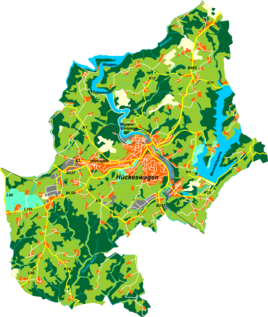Oberhombrechen
|
Oberhombrechen
City of Hückeswagen
Coordinates: 51 ° 10 ′ 37 ″ N , 7 ° 20 ′ 10 ″ E
|
||
|---|---|---|
| Height : | 313 m above sea level NN | |
| Postal code : | 42499 | |
| Area code : | 02192 | |
|
Location of Oberhombrechen in Hückeswagen |
||
Oberhombrechen is a court in Hückeswagen in the Oberbergischer Kreis in the administrative district of Cologne in North Rhine-Westphalia ( Germany ).
Location and description
Oberhombrechen is located in the northern part of Hückeswagen above the Wuppertalsperre near the city limits to Radevormwald . Neighboring places are Vormwald , Mittelhombrechen , Niederhombrechen , Mitberg , Niederbeck , Kormannshausen , Neukretze and Karrenstein . The village can be reached via an access road which branches off from the K11 district road between Neuenherweg and Kormannshausen and which also connects Vormwald, Mittelhombrechen and Karrenstein.
The Ressiepen stream , a tributary of the Wiebach, rises to the west of Oberhombrechen and the Oberhombrechener Siepen stream rises to the east and flows into the Wiebach pre-dam of the Wuppertal dam.
history
In 1481 the place was mentioned for the first time in a list of donations for the Marien Altar of the Hückeswagen church. Spelling of the first mention: zo Hombrechen . The map Topographia Ducatus Montani from 1715 shows the farm as a Hombreck . In the 18th century the place belonged to the Bergisches Amt Bornefeld-Hückeswagen .
In 1815/16 23 people lived in the village. In 1832, Oberhombrechen belonged to the Herdingsfelder Honschaft , which was part of the Hückeswagen external citizenship within the Hückeswagen mayor, under the name Heinhombrechen . The place, categorized as a hamlet according to the statistics and topography of the Düsseldorf administrative district , had four residential buildings and four agricultural buildings at that time. At that time, 31 residents lived in the village, six of them Catholic and 25 Protestant.
In the municipality lexicon for the Rhineland province in 1885, five houses with 30 inhabitants are given. At that time the place belonged to the rural community Neuhückeswagen within the Lennep district . In 1895 the place had seven houses with 31 inhabitants, in 1905 five houses and 36 inhabitants.
Attractions
A wind turbine is operated on a hill near the courtyard. The Wiebach pre-barrier of the Wuppertalsperre offers ornithologists a worthwhile observation area for water birds. The old, non-existent restaurant “ Schlappenbühl ” used to be important for the place .
Hiking and biking trails
The following hiking trails lead through the village:
- The SGV main hiking route X7 ( Residenzenweg ) from Arnsberg to Düsseldorf-Gerresheim
- The local circular route A10
Individual evidence
- ^ Klaus Pampus: First documentary naming of Oberbergischer places (= contributions to Oberbergischen history. Sonderbd. 1). Oberbergische Department 1924 eV of the Bergisches Geschichtsverein, Gummersbach 1998, ISBN 3-88265-206-3 .
- ^ Johann Georg von Viebahn : Statistics and topography of the administrative district of Düsseldorf. Part 2: Containing the statistical table of places and distances and the alphabetical index of place names. Schreiner, Düsseldorf 1836, p. 12 .
- ^ Royal Statistical Bureau (Prussia) (Ed.): Community encyclopedia for the Rhineland province. Based on the materials from the census of December 1, 1885 and other official sources (= community encyclopedia for the Kingdom of Prussia. Vol. 12, ZDB -ID 1046036-6 ). Publishing house of the Royal Statistical Bureau, Berlin 1888.
- ^ Royal Statistical Bureau (Prussia) (Ed.): Community encyclopedia for the Rhineland province. Based on the materials from the census of December 1, 1895 and other official sources (= community encyclopedia for the Kingdom of Prussia. Vol. 12). Publishing house of the Royal Statistical Bureau, Berlin 1897.
- ^ Royal Statistical Bureau (Prussia) (Ed.): Community encyclopedia for the Rhineland province. Based on the materials from the census of December 1, 1905 and other official sources (= community encyclopedia for the Kingdom of Prussia. Vol. 12). Publishing house of the Royal Statistical Bureau, Berlin 1909.

